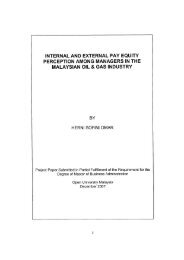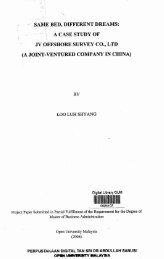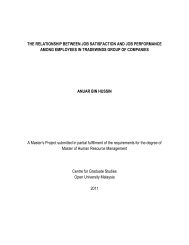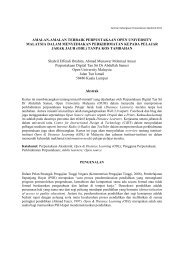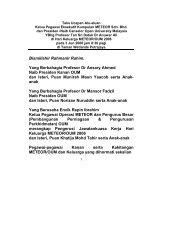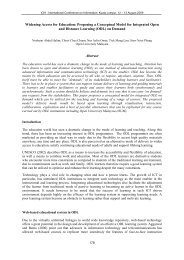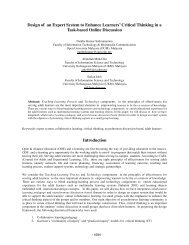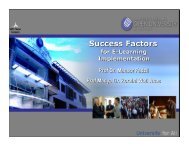Contingent Valuation Method: Valuing Cultural Heritage Chiam ...
Contingent Valuation Method: Valuing Cultural Heritage Chiam ...
Contingent Valuation Method: Valuing Cultural Heritage Chiam ...
Create successful ePaper yourself
Turn your PDF publications into a flip-book with our unique Google optimized e-Paper software.
<strong>Contingent</strong> <strong>Valuation</strong> <strong>Method</strong>: <strong>Valuing</strong> <strong>Cultural</strong> <strong>Heritage</strong><strong>Chiam</strong> Chooi <strong>Chiam</strong>, R. Alias, A.R. Khalid & Y. RusliAbstract<strong>Cultural</strong> heritage is not easy to be valued in a market because it is a very unique product which gives acommunity (ies), nation(s) an identity and a sense of belonging. Debate on the valuation of culturalheritage surrounds despite growing attention by economists and policy makers. The attention on theestimation of economic values for cultural goods and services has been great by economics throughoutthe past two decades (Choi, et al., 2009; Kaminski, McLoughlin, & Sodagar, 2007; Navrud & Ready,2002, Noonan, 2003; Venkatachalam, 2004). The two stated preference methods which are commonlyused in valuing non-use goods; i.e. contingent valuation method and choice modelling. Each of these twovaluation method has its own strengths and weaknesses and may even complement each otherdepending on the parameters of the study. However, according to Kaminski et al., 2007; Noonan, 2003,the usage of choice modelling to estimate cultural values has been limited due to the growing usage ofcontingent valuation. Therefore, this paper will discuss contingent valuation method in valuing amenitiesand aim to contribute the knowledge on contingent valuation method for nonmarket goods.1. IntroductionPeople all over the world need to be made aware of the importance of cherishing our varied heritage,both the treasures of our physical cultural heritage and the intangible heritage of traditions and culturalpractices. In learning to appreciate and value our own heritage, we can learn to appreciate the heritage ofother cultures. This is an essential step towards ensuring peaceful dialogue and mutual understandingamong nations. Furthermore, heritage preservation is essential if we are to retain the wealth of ourcultural diversity and ensure that the world is enriched rather than impoverished by globalization.<strong>Heritage</strong> includes different forms of cultural capital “which embodies the community’s value of its social,historical, or cultural dimension” (Throsby, 1997, p.15). <strong>Heritage</strong> covers a large range of goods, whosedefinition changes over time and space and depends on the variety of dimensions eg symbolic, cultural,national identity-oriented and social. (Chastel, 1986).According to Throsby (2006), heritage is something inherited from the past and attaching the adjective“cultural” to it defines its scope more precisely. It refers to inherited things that have some culturalsignificance. Based on a study by Peacock (1997, p.195), he argued that heritage is “an intangibleservice increasing the utility of consumers, in which historic buildings and artifacts are inputs”. With thisdefinition, it recognizes the existence of substitutes for goods that have some characteristics in common.This conception presents the advantage of including services offered through new technologies.Tangible and intangible heritage attracted an increasing number of domestic and international tourists asthe needs of the tourists have evolved from mere satisfaction of curiosity and relaxation to a learning andappreciation of local heritage, which includes both tangible and intangible (Graburn,1989).2. Characteristics of <strong>Cultural</strong> <strong>Heritage</strong>According to the 1972 World <strong>Heritage</strong> Convention, cultural heritage may be directly or tangibly associatedwith living traditions, ideas or beliefs, artistic and literary works of universal significance. <strong>Heritage</strong> sites areinvaluable because of their significance to a former era of humankind; visitors of authentically preservedcultural heritage sites might feel transported to the previous era. The term intangible cultural heritage canbe used interchangeably with the term living heritage. Culture such as dances, music, theatre and crafttraditions are invaluable because they manifest dynamic communities and groups in response to theirenvironment, their interaction with nature and their history they provide communities with a sense of
identity and continuity. <strong>Heritage</strong> are bound to tradition and also constantly evolving and depends on thecommunity to maintain and transmit them to future generations.<strong>Cultural</strong> goods can be seen where they are have public good characteristics, where indivisibilitycharacteristic prevails. The consumption of publicly-owned goods is identical for all consumers. The othercharacteristic is externality, a source of market failure for heritage goods. <strong>Heritage</strong> constitutes a legacy tobe passed on to future generations known as bequest value. <strong>Heritage</strong> also confers benefits on individualcitizens, who have not contributed to their production or preservation. Moreover, excludability is notalways possible or desirable. Greffe (1999), addressed the question whether to charge a price or not(when possible) on cultural heritage. He analysed price discrimination policies in heritage buildings andsites, emphasizing the lack of clarity due to the large variety of policies.There are characteristics of cultural goods which give rise to their cultural value, aptly named, aestheticproperties, spiritual significance, role as purveyors of symbolic meaning, historic importance, itssignificance in influencing artistic trends, authenticity, integrity, uniqueness and many more (Throsby,2003)3. Economic <strong>Valuation</strong>Although there are aspects of cultural value that cannot be expressed in monetary terms, this does notimply that the implicit cultural value assigned to a cultural good in an economy study is zero. In the past,heritage experts tend to regard economists as being insensitive and heavy-handed, focused too singlemindedlyon financial measurement, and overlooking the true cultural significance of heritage assets(Cannon-Brookes, 1996). There is a distinction value of cultural goods and services between economicand cultural value (Hutter & Throsby, 2008).The definition of benefits as willingness to pay implies the existence of a demand curve for the effects ofimproved amenities quality. Benefits can be taken to be equal to the area under the demand curve.Benefit estimation involves determining the shape of the demand curve for amenities quality.In economics, the usual practice is to use money as the standard welfare measurement because it isfinely divisible, and it represents general purchasing power of a large range of goods and services.Money will make a particularly effective measurement for the benefits of non-use goods. Benefits andcost that occurred with a change in the quantity of an environmental amenity is measured in terms ofindividual preferences 1 .The measurement of benefits is the willingness-to-pay (WTP) or the willingness-to-accept (WTA)compensation to forgo that benefit. On the other hand, the measurement of cost is the WTP to avoidsuffering the loss of welfare, or the WTA to suffer that loss. These measurement of benefits and costsunderlie the concept of economic efficiency, where economic efficiency increases if the sum of thebenefits to the gainers (due to reallocation of resources) exceeds the sum of the costs to the losers(Bateman et al., 2002).There are two methods for measuring the WTP and WTA, namely the Revealed Preference (RP) methodand the Stated Preference (SP) method. The main difference between these two methods is that RPmethod draws data from observations of actual choices made by people in the real world, while the SPmethod gathers data from people’s responses to hypothetical questions instead. Therefore, the RPmethods cannot be used when there is non-use values involved. Benefits and cost that occurred with achange in the quality of an environmental amenity are measured in terms of individual preferences. Asmentioned earlier, money is used as a standard welfare measurement. Figure 1 illustrates the overviewavailable economic measurement techniques for use value and non-use value.1 It is assumed that an individual’s well-being can be represented by an ordinal utility function.
Total Economic ValueUse ValueNon-use ValueRevealed Preferences(RP) - Real MarketStated Preferences (SP)- Hypothetical MarketTravel Cost<strong>Method</strong>HedonicPricingAvertingbehaviorMarketpricesChoicemodelling<strong>Contingent</strong><strong>Valuation</strong>Figure 1 Economic valuation techniques, Source: Andy S. Choi et al (2009) modified from Fig.1.4 ofBateman et al. (2002: p.30)4. <strong>Contingent</strong> <strong>Valuation</strong> <strong>Method</strong> (CVM)CVM is used to estimate economic values for all ecosystems and environmental services. It can be usedto estimate both use and non-use values, and it is the most widely used method for estimating non-usevalues. This method involves directly asking individual, in a survey, how much they would be willing topay for specific environmental services. Individuals are asked for the amount of compensation theywould be willing to accept to give up specific environmental services. It is called contingent valuationbecause people are asked to state their willingness to pay, contingent on a specific hypotheticalscenarios and description of the environmental service. The fact that CVM is based on what people saythey would do, as opposed to what people are observed to do is its greatest strengths and its greatestweaknesses as well.CVM is a survey approach designed to create the missing market for public goods by determining whatpeople would be willing to pay (WTP) for specified changes in the quantity or quality of such goods, ormore rarely, what they would be willing to accept (WTA) in compensation for well-specified degrations inthe provision of these goods (Hanemann 1994; Bateman et al. 2002). CVM circumvents the absence ofmarkets for natural resource services by presenting consumers with a choice situation in which they havethe opportunity to buy or sell the services in question. The overview of CVM application in variousresearch studies should be necessarily appreciated in order to facilitate the discussion of the method.
Based on Hanley & Spash, (1993); Chan (2009), the CVM is generally divided into six stages. Thesestages are as follows:1. Setting the hypothetical market;2. Obtaining bids;3. Estimating mean willingness-to-pay (WTP) or willingness-to-accept (WTA), or both;4. Estimating bid curves;5. Aggregating the data; and6. Evaluating the CVM exercise5. The Use of CVM To Assess Environmental AmenitiesOne of the earliest practical applications of the contingent valuation method to elicit the market valuationfor nonmarket goods was by Davis (1963) where he estimated the value that hunters and tourists placedon a particular wilderness area. In his study, he found a significant correlation survey result usingestimation on the travel cost method. CVM was even recommended as the assessment when USgovernment agencies were given the power to sue for damage to environmental resources (included nonuse,or existence values) in the 1980s.The importance of valuing nonmarket goods was brought to light with the Exxon Valdez oil spill in PrinceWilliam Sound. Carson et al., (1994) used CVM in a quantitative assessment of damages for the ExxonValdez oil spill in Prince William Sound case. This case used the most carefully developed CVMquestionnaires at that time. Another significant case of CVM application is valuing the preservation ofAustralia’s Kakadu Conservation Zone conducted by Carson et al., (1994). Both of the studies werefunded by their government respectively and both studies also involved a great and in-depth exploring ofthe CVM application on these projects. These studies give a great insight to CVM especially in their stepby-stepapproach and the development of the hypothetical scenarios to represent the assessment ofenvironmental amenities.6. Assumptions Used In CVMThere are several assumptions used in CVM in eliciting the value of non-use goods in the market. It is tobe reminded again that CVM is predicted on a model of an economy comprised of individual decisionmakers who behave rationally in maximizing their own utility taking the considerations of knownconstraints. It is assumed that individuals are the best judges of their own welfare, where each individualcarries equal weight in the aggregation of preferences. CVM works under a well-behaved preferencesystem between goods and the social welfare function contains no arguments other than the welfare ofthe individuals of which society is composed. Generally, CVM accepts that consumers have well-definedpreferences for public goods and that this demand can be measured by the amount of other goods thatthey are prepared to sacrifice to acquire a unit of the good in question.7. Strengths and Limitations of CVMThere are claims that WTP studies can be bias. Biases such as free-riding, the embedding problem,starting-point bias, mixed-good bias etc, can now be effectively controlled for, at least their effects onestimated WTP on the study by Mitchell and Carson (1989). However, the main problem when CVM takeson a specific significance when WTP techniques are applied to cultural goods is the information problem,or in a more precise manner, its converse ignorance. In CVM, it is well-known that the amount ofinformation provided to respondents has a critical effect on their WTP judgments, with well-informedjudgments are better than ill-informed judgments. According to Throsby, (2003) study, in an “ordinary”public good such as national defense or even environmental amenity, it would be able to provide enoughinformation for an informed response to be generated, at least in principle. However, distinguish feature ofcultural goods acquires a taste for them takes time, where they are classed as experiential, their demand
is cumulative, and hence it would be dynamically unstable. Throsby, (2003) stated that individual’s WTPwill not be able to provide a complete view of the nonmarket value of a cultural good. For example, anindividual may acknowledge that a good has a value to him/her but he/she cannot meaningfully representthe benefit he/she gained from this good in monetary terms. Other than that, an individual may enjoy thebenefits of being identified as a human being (sharing a common humanity with his/her fellow citizens),but neither he/she are likely able to express the value of this identity in monetary terms, since it is notexchangeable for other goods. Another issue arise from CVM is on the hypothetical market of anonmarketed good. Hypothetical market for nonmarketed good does not encompass a common groundthat both researchers and subjects anticipate.The CVM should be opted when the WTP for the environmental amenity in total is required, as opposedto the WTP for comparison of different values for individual attributes of the amenity (Bateman et al,2002). Therefore, if the researcher would like to find out the value of conserving the current level of acultural heritage as a whole, the CVM should be chosen. Meanwhile, if the researcher, on the other hand,would like to find the value of observing one level of a cultural heritage versus a different level of thecultural heritage, then the Choice Modeling (CM) 2 method should be opted.8. ConclusionCVM lies under a set of assumptions and based on hypothetical scenarios and questions. Despite itsunderlying weaknesses, quite a number of progresses have been made in refining CVM techniques toovercome the formidable difficulties in its application. There have been vast studies on the estimation ofeconomic values for nonmarket goods throughout the past two decades. Although there is a growingrecognition of the broader economic value of cultural goods by academics, government policy makersand industry, there are not many studies undertaken in Malaysia to estimate their economic value acrossthe whole nation. The future research can be done on valuing the benefits of preserving the cultural livingheritage in Malaysia, a developing nation using various SP approaches in a hypothetical market.2 Choice modelling attempts to model the decision process of an individual or segment in a particular context.Choice modelling may also be used to estimate nonmarket environmental benefits and costs. It is another SP methodavailable for making probabilistic predictions about human decision making behaviour.
References1. Andy S.Choi, Brent W. Ritchie, Franco Papandrea, Jeff Bennett. (2009). ‘Economic valuation ofcultural heritage sites: A choice modeling approach’, The Tourism Management, 31(2010), 213-220.2. Bateman, I. J., Carson, R. T., Day, B., Hanemann, M., Hanley, N., Hett, T., (2002), ‘Economicvaluation with stated preference techniques: A manual’, Northampton, MA: Edward Elgar.3. Cannon-Brookes, Peter (1996), “<strong>Cultural</strong>-economic analysis of art museums: a British curator’sviewpoint”, in Victor Ginsburgh and Pierre-Michel Menger (eds.), Economics of the Arts: SelectedEssays. Amsterdam: North-Holland, pp. 255–277.4. Carson, R.T., Wilks, L. and Imber, D. (1994). ‘<strong>Valuing</strong> the Preservation of Australia’s KakaduConservation Zone’, Oxford Exonomic Papers, New Series, 46,727-749.5. Chastel, A. (1986), ‘La notion de patrimoine’, in P. Nora (ed.), Les lieux de mémoire, Vol. 2, Paris:Gallimard, pp.405–50.6. Davis, R. (1963). ‘Recreation planning as an economic problem’, Natural Resources Journal, 3(2),239-249.7. Graburn N. (1989) Tourism: The Sacred Journey, Smith V. L. (ed.), Hosts and Guests: TheAnthropology of Tourism, Basil Blackwell 2nd Edition.8. Greffe, X. (1999), La gestion du patrimoine culturel, Paris: Anthropos.9. Hanemann, W.M. (1994). ‘<strong>Valuing</strong> the environment through contingent valuation’, Journal ofEconomic Perspectives, 8(4), 19-43.10. Hanley, N. and Spash, C.L., (1993). ‘ Cost-Benefit Analysis and the Environment’, Edward ElgarPublishing Limited11. Hutter, Michael and David Throsby (eds.) (2008), Beyond Price: Value in Culture, Economics, and theArts, New York: Cambridge University Press.12. Kaminski, J., McLoughlin, J., & Sodagar, B. (2007). ‘Economic methods for valuing European culturalheritage sites (1994–2006)’. In J. McLoughlin, J. Kaminski, & B. Sodagar (Eds.), Perspectives onimpact, technology and strategic management (pp. 98–121). Budapest: EPOCH13. Lilian M.L. Chan, (2009), ‘The conservation of a living heritage in inner George Town, Penang Island’,PhD thesis submitted to School graduate Studies, Universiti Putra Malaysia.14. Mitchell, R.C. and Carson, R.T. (1989). ‘Using surveys to value public goods” the contingent valuationmethod’, Resources for the future, Washington DC.15. Navrud, S., & Ready, R. C. (Eds.). (2002). ‘<strong>Valuing</strong> cultural heritage: Applying environmentalvaluation techniques to historic buildings, monuments and artifacts’, Cheltenham, UK: Edward Elgar.16. Noonan, D. (2003). ‘<strong>Contingent</strong> valuation and cultural resources: A meta-analytic review of theliterature’, Journal of <strong>Cultural</strong> Economics, 27, 159–176.17. Peacock, A. (1997), ‘A Future for the Past: the Political Economy of <strong>Heritage</strong>’, in R. Towse (ed.),<strong>Cultural</strong> Economics: the Arts, the <strong>Heritage</strong> and the Media Industries, vol.1, Cheltenham, UK andLyme, US: Edward Elgar, pp.189–243.
18. Throsby, D. (1997). ‘Seven Questions in the Economic of <strong>Cultural</strong> <strong>Heritage</strong>’. Economic Perspectiveson <strong>Cultural</strong> <strong>Heritage</strong>, eds. Michael Hutter and Ilde Rizzo, St. Martins Press Inc., New York, 13-30.19. Throsby,D. (2003). ‘Determining the Value of cultural goods: How much (or how little) does contingentvaluation tell us? , Journal of <strong>Cultural</strong> Economics, 27, 275-28520. Throsby.D., (2006), ‘Paying for the past: Economics, <strong>Cultural</strong> <strong>Heritage</strong> and Public Policy, Text ofJoseph Fisher Lecture, delivered at the University of Adelaide, 16 August, 2006.21. Venkatachalam, L. (2004). ‘The contingent valuation method: a review’, Environmental Impactassessment Review, 24(1), 89-124



